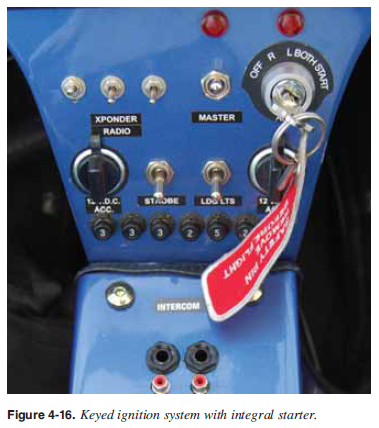
 |
|
||
| CHAPTER 4. Powerplants
Ignition System The typical ignition system on WSC aircraft provides the spark that ignites the fuel/air mixture in the cylinders and is made up of magneto/generators, control boxes, spark plugs, high-voltage leads, and the ignition switch. For most LSA engines designed specifi cally for aircraft, a magneto/ generator uses a permanent magnet to generate an electric current independent of the aircraft’s electrical system, which might include a battery. The aircraft electrical system can fail—the battery can go dead. However, this has no effect on the ignition system. The electricity from the ignition magneto/generator goes into the ignition control box where the correct voltage is produced and timed to fi re the spark plugs at the proper time. Modern WSC aircraft use an electronic capacitance discharge system that operates without any moving parts to increase reliability and effi ciency. Capacitance Digital Systems (CDI) operate similarly but they have the ability to change the timing of the spark for different rpm. Consult the POH for the particular system for each engine. The system begins to fi re when the starter is engaged and the crankshaft begins to turn. It continues to operate whenever the crankshaft is rotating. Most WSC aircraft incorporate a dual ignition system with two individual magneto/ generators, separate sets of wires, separate sets of control boxes, and separate sets of spark plugs to increase reliability of the ignition system. Each magneto/generator operates independently to fi re one of the two spark plugs in each cylinder. If one of the systems fails, the other is unaffected. The engine will continue to operate normally, although a slight decrease in engine power can be expected. The operation of the magneto/generator output to the ignition system is controlled in the fl ight deck by the ignition switch. Since there are two individual ignition systems, there are normally two separate ignition toggle switches or separate positions on the ignition control, as shown in Figure 4-16.  Identifi cation of a malfunctioning ignition system during the pretakeoff check is observed by the decrease in rpm that occurs when fi rst turning off one ignition switch, turning it back on, and then turning off the other. A noticeable decrease in engine rpm is normal during this check. If the engine stops running when switching to one ignition system or if the rpm drop exceeds the allowable limit, do not fl y until the problem is corrected. The cause could be fouled plugs, broken or shorted wires between the magneto/generator and spark plugs, or improperly timed fi ring of the plugs because of a defective control box. It should be noted that “no drop” in rpm is not normal, and in that instance, the aircraft should not be fl own. Following engine shutdown, keep the ignition switches in the OFF position. Even with the battery and master switches OFF, the engine can fi re and turn over if an ignition switch is left ON and the propeller is moved because the magneto/generator requires no outside source of electrical power. The potential for serious injury in this situation is obvious. Standard category aircraft engine systems are described in the Pilots Handbook of Aeronautical Knowledge; however, these engines are not typically used on WSC. Automobile engines or other non aircraft engines may be used on WSC where the ignition system runs off the battery rather than a magneto/generator system. In this case if the battery system fails, the engine ignition system will fail and the engine will stop. Combustion During normal combustion, the fuel/air mixture burns in a very controlled and predictable manner. Although the process occurs in a fraction of a second, the mixture actually begins to burn at the point where it is ignited by the spark plugs, then burns away from the plugs until it is consumed completely. This type of combustion causes a smooth buildup of temperature and pressure and ensures that the expanding gases deliver the maximum force to the piston at exactly the right time in the power stroke. Detonation is an uncontrolled, explosive ignition of the fuel/air mixture within the cylinder’s combustion chamber. It causes excessive temperatures and pressures which, if not corrected, can quickly lead to failure of the piston, cylinder, or valves. In less severe cases, detonation causes engine overheating, roughness, or loss of power. Detonation is characterized by high cylinder head temperatures and is most likely to occur when operating at high power settings. Some common operational causes of detonation include:
Detonation may be avoided by following these basic guidelines during the various phases of ground and fl ight operations:
Preignition occurs when the fuel/air mixture ignites prior to the engine’s normal ignition event. Premature burning is usually caused by a residual hot spot in the combustion chamber, often created by a small carbon deposit on a spark plug, a cracked spark plug insulator, or other damage in the cylinder that causes a part to heat suffi ciently to ignite the fuel/air charge. Preignition causes the engine to lose power and produces high operating temperature. As with detonation, preignition may also cause severe engine damage because the expanding gases exert excessive pressure on the piston while still on its compression stroke. Detonation and preignition often occur simultaneously and one may cause the other. Since either condition causes high engine temperature accompanied by a decrease in engine performance, it is often diffi cult to distinguish between the two. Using the recommended grade of fuel and operating the engine within its proper temperature and RPM ranges reduce the chance of detonation or preignition. |
| ©AvStop Online Magazine Contact Us Return To Books |